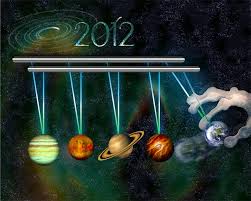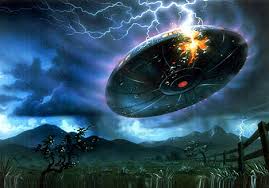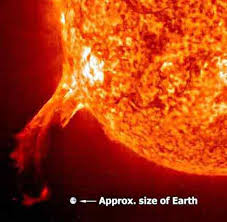Everywhere you turn, it seems, conversations are abuzz with the idea that something bad could happen in 2012. Maybe, like Ray Bradbury wrote, "something wicked this way comes?" Maybe Gaia is stressed out, her resources swiftly depleting. She's inervated by our remorseless species -suckling like tiny vampires at Mother Earth's teats, devouring her milk till she's just about drained dry - and a little less than three more years is all that she can take? Do planets go postal - erupting in earth-shattering fury from frustration pent-up over millenia - and finally just explode? Can someone go and ask Ceres?
That 590 mile diameter asteroid could be the largest remnant left of a former planet that used to circle between Mars and Jupiter, just before her Mom had a nervous breakdown. Why don't we dub this hypothetical planet Opis, until someone comes up with a better name? Opis, which means plenty in Latin, was an earth goddess - who in Roman mythology of Sabine origin - was worshipped as a fertility deity. Coupling with her brother Saturn, they produced offspring Pluto, Juno, Jupiter, Neptune, Ceres, and Vesta.
Vesta was discovered in 1807 by German astronomer Heinrich Wilhelm Olbers. He deferred the honor of naming it to prominent mathematician Carl Friedrich Gauss. This second largest nomad of the asteroid belt is an approximately 362 mile diameter slow-tumbling rock. An enormous 290 mile wide impact crater, nearly 80% of its width, indicates that Vesta was struck nearly a billion years ago, losing up to one percent of her volume during that occurence. Ummm, how can they gauge this with such precision? Were our astral alien ancestors parked in nearby UFO's conducting observation? "Oooh weeh oooh," the Twilight Zone music plays.
3 Juno is another asteroid, and the Juno clump refers to an asteroid family in the proximity of 3 Juno. Thus, we can see that all the offspring of the mythological pairing of Opis with Saturn resulted in awarding the names of the big brothers to planets, and their siblings to asteroids. Apparently, the German's - at least their astronomers and mathematicians - retain a droll sense of humor as demonstrated by their taxonomic designations of names for the asteroids. I think Opis is perfectly appropriate as a name then, and I plan on filing a Missing Persons Report on this planet with the Astronomy Police.
What did cause all those fragments circling Sol, in orbit between the fourth and fifth planets? Did a planet once exist there? Enough residual rounding remnants remain that if things ever got really boring up there on Mount Olympus, if an inebriated Zeus and his plastered boys Apollo and Ares - like a wine-swilling male trio bonding on a Family Night bacchanale - could assemble them like a gigantic 9,350,000 piece Ravensburger puzzle entitled "Planetary Migraine, My Head is About to Explode" they would only form a planetoid less than 1/3 to 1/2 the diameter of the moon. But I digress.
There are a couple of theories tossed around by debating scientists that could account for the presence of the asteroids. One theorizes that what we see now, orbitting 251,000,000 miles - or 2.7 AU (astronomical units), the distance from Earth to the Sun - is the remains of a planet. The Titius–Bode law is a hypothesis which puts forth that bodies in some solar systems orbit at predictable distances from the sun, which can be determined as an exponential function of planetary sequence. Sixteenth century mathematicians, working without the advanced telescopy available today, predicted the presence of a planetary mass at 2.8 AU, even though none of the smaller asteroids had been discovered at that time.
Dr Tom Van Flandern is an American astronomer who has - since the late-1970's - amassed an impressive body of evidence, the compilation of which continues to contribute momentum to convince skeptics of his claim that a planet once existed in this orbital plane. His brainchild was initially repudiated by academia, as it controverted mainstream scientific orthodoxy of that era, but since which time its plausibility has leant considerably to its credence. He has written several analytical expositories propounding the Exploding Planet Hypothesis, and his publications may be found in scientific annals. He is also the author of the book Dark Matter, Missing Planets and New Comets.
The major proponent of EPH, researcher Van Flandern postulates that there may well have been a planet that ruptured. Evidence of just that is to be found on Mars, which may once have been a moon of Opis. Van Flandern states, "If a massive planet had blown up nearby, it would blast the facing hemisphere with craters, and leave the shielded hemisphere relatively unscathed. Especially significant in this regard is the fact that half of Mars is saturated with craters, and half is only sparsely cratered." http://metaresearch.org/solar%20system/eph/eph2000.asp.
Astrophysicist John Chambers, of the Carnegie Institution in Washington DC, declares the size distribution of craters on the Moon better match asteroids from the Asteroid Belt, located beyond the orbit of Mars. He thinks the misbehaviour of a long-lost, fifth rocky planet called 'Planet V' was the trigger that upset the gravitational balance of the belt and ejected some of its inhabitants. Planet V's orbit was between that of Mars and the Asteroid Belt, Chambers predicts, and it may have been smaller than Mars but larger than our Moon. http://www.cosmosmagazine.com/node/1691
The viewpoint of the oppositional camp, held by most planetary astronomers, is the belief that "the planets of the Solar System formed from a nebula of gas and dust that coalesced into a disk of dust grains around the developing Sun. Within the disk, tiny dust grains coagulated into larger and larger bodies called planetesimals, many of which eventually accreted into planets over a period as long as a 100 million years. However, beyond the orbit of Mars, gravitational interference from Jupiter's huge mass prevented protoplanetary bodies from growing larger than about 620 miles." http://www.world-mysteries.com/sci_8.htm.
They also like to refute EPH by insisting it relies on specious logic. They support this by adding that the problem with the Asteroid Belt being the remnants of a destroyed planet is that its total mass is very small, very much less than the mass of the Moon. It has been estimated that the total mass of the Main Asteroid Belt may total less than 1/1000th of the mass of the Earth. So where did the rest of it disappear? Dr. Dan Durda suggests an answer that, if lacking the correct context, provides forensic support for either party. Durda is a planetary scientist at the Southwest Research Institute in Boulder, CO. His friends jokingly refer to him as an astronomy evangelist who sermonizes about asteroid impacts and extinction events.
"The Main Asteroid Belt is only a small remnant of the material that once resided in the region between Mars and Jupiter, but once may have contained between two to 10 Earth masses of material. However, T-Tauri-type Solar winds from a very young Sun, gravitational perturbations from Jupiter developing nearby, and dynamic interactions with other large planetesimals and protoplanets during the first 100 million years, and continuing collisional grinding over the following 4.5 billion years after the formation of the planets, interfered with the formation of a substantial, single planet and caused most of the mass to be lost to the rest of the Solar System and interstellar space." (Dan Durda, "Ask Astro," Astronomy, December 2000).
I prefer Van Flandern's theory, even if he does neglect to utilize the appellation Opis. He says exploding planets have happened before, not just once but at least twice in the history of our solar system. He points to evidence that another asteroid belt, possibly two, circle the sun in orbit beyond Neptune. Could this happen again? To Mars, or Venus? Look what happened the last time, when Opis exploded. The biosphere of the Earth was pummelled with huge fragmentary cinders. One was large enough - estimated at six miles in diameter - to leave a 110 mile wide impact crater where it struck at Chicxulub, Mexico in the Yucatan peninsula.
This happened 65,000,000 years ago, during the K-T boundary. From Wikipedia we learn: "The K–T boundary is a geological signature, usually a thin band, dated to (65.5 ± 0.3) Ma (megaanum, or million years ago). K is the traditional abbreviation for the Cretaceous period, and T is the abbreviation for the Tertiary period. The boundary marks the end of the Mesozoic era and the beginning of the Cenozoic era, and is associated with the Cretaceous-Tertiary extinction event, a mass extinction." No more Triceratops, Stegasaurus, or Brontosaurus.
What gives scientists confidence that an impact event caused the extinction? K-T boundary sedimentary rock layers around the world have been found to contain iridium concentrations much higher than is normal for geological formations. Iridium is an extremely rare element, and the levels found at this demarcation are 30 to 130% more than would be expected. Meteorites and asteroids are known to contain iridium levels as much as fifteen hundred times greater than terrestrial strata. So they're pretty sure the damage resulted from a rock the size of Manhattan clobbering us. The impact would have had the force of 100 trillion tons of TNT, about 2 million times more powerful than the biggest nuke ever tested.
So what happened the one time Chicken Little, clucking "the sky is falling, the sky is falling" was right? No one knows for sure, but scientists imagine three possible scenarios: Some think the impact threw massive quantities of dust into the atmosphere which blocked the sun and arrested plant growth. Others believe sulfur released by the impact lead to global sulfuric acid clouds that blocked the sun and also fell as acid rain. Another possibility is that red-hot debris from the falling asteroid or comet triggered global wildfires. Or it could be some combination of each. http://news.nationalgeographic.com/news/2003/03/0307_030307_impactcrater.html
Could our solar system experience the complete destruction of a planet for the third time? Could there be some type of extinction level event, threatening to obliterate our species, approaching in 2012? Are all of these fearmongering rumor spreaders right? Or are they just pitiable scared homonids running about, aping what others have said? If they're right, come 2013, homo sapiens will no longer be the only extant species of the family Hominidae. We could be joining the other homos, the upright bipedal primates like habilis, floresiensis, and neanderthalensis, who like australopithecus before them took their curtain call and became extinct. Come midnight on December 21, 2012, we could all be exiting stage left as we share the sentiment "Man, it's been real, but I'm outta here."
Tuesday, January 5, 2010
Subscribe to:
Post Comments (Atom)












































No comments:
Post a Comment